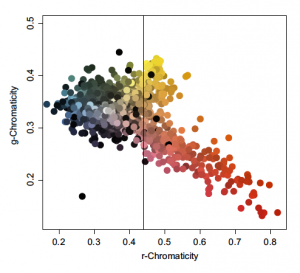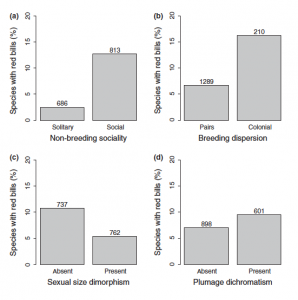The saying, “Birds of a feather flock together” is a testament to the incredibly important role bird feathers have in signaling between individuals. Birds can be found in a wide range of colors, and the function of plumage coloration for both sexual and nonsexual communication has been well studied. A group of researchers focused their attention on the other parts of birds that can be colorful, what they call “bare parts,” that include the legs, eye rings, bills, wattles, and crests. Dey et al. (2015) hypothesized that these parts should be important in signaling because they are easily visible and come in a variety of colors. Their recently published study explores this question by examining beak coloration in Passeriformes, which are also known as songbirds or perching birds.

“Red-browed Finch (Neochmia temporalis), Cleland Wildlife Park, near Mount Lofty, Adelaide, South Australia.” Author: Peripitus
The researchers were most interested in carotenoid pigments, which are those that produce red, orange, and yellow coloration. This pigment was chosen not only because it is the most common one in bird bare parts, but because animals do not produce it naturally. They instead obtain it from their environment by eating plants that contain the pigments (fun fact: koi fish are given carotenoid supplements to achieve their bright coloration!). Since the pigments have to be obtained from the environment, the coloration of the bill reflects what the bird has eaten, which is also tied to reproductive status and overall health. Dey et al. (2015) wanted to test the idea that carotenoid bill coloration has evolved as a social signal for things such as rank and competition for resources. If the researchers’ hypothesis is correct, they would see a positive relationship between carotenoid bill coloration and birds that live in flocks during the non-breeding season or birds that nest in a colony.

Fig. 1 “Red–green chromaticity colour space of passerine birds. For each species, one point is plotted for each of the upper and lower mandible of the male and female (i.e. four points per species). Point colour is determined from tri-stimulus values measured from colour plates in handbooks (see text). In the main analysis, species were classified as having a carotenoid-based bill if their rchromaticity score was above 0.44 (vertical line).” Dey et al. (2015)
To test their hypothesis, Dey et al.(2015) collected bill color data from images in the Handbook of the Birds of the World. This allowed them to get samples fairly easily and consistently, allowing for a larger sample size. They looked at 1605 passerine species found in Africa, Australia, and New Zealand because they live in diverse areas and are fairly representative of the order. Songbirds overall are extremely diverse and widespread, and make for good subjects for study. Images were scanned, and a computer program was used to analyze the color of the birds’ bills. Researchers then paired this information with the life history traits of the birds, focusing on sociality during the non-breeding season and whether or not they are colonial, rather than dispersed, breeders. They also examined traits that were related to sexual selection such, as size and color difference between males and females (sexual dimorphism or sexual chromatism), for comaprison.

Fig. 3 “Percentage of species with carotenoid bill coloration as a function of (a) sociality in the nonbreeding season and (b) breeding dispersion (c) sexual size dimorphism and (d) plumage dichromatism. Numbers above each bar indicate number of species in each category. For graphical purposes only, sexual size dimorphism was considered to be present if there was at least a 4% difference in wing length between males and females. Similarly, sexual dichromatism was scored as present if there was at least a slight difference in coloration between males and females (i.e. a nonzero score for sexual dichromatism).” Dey et al. (2015)
The researchers did get results that aligned with their hypothesis: carotenoid bill coloration is more common in species that live in groups during the non-breeding season and in those that are colonial breeders. They also found that the coloration was not related to the traits associated with sexual selection. These results have huge implications for the evolution of color in birds! The research suggests that carotenoid bill coloration has evolved mainly as a signal during competitive interactions rather than for sexual communication. The color of the beak can reflect the bird’s overall quality as well as its dominance rank and ability to fight. While beak coloration can still be a signal used in mate selection, Dey et al.’s study (2015) shows that it is more strongly associated with social grouping behaviors. Having carotenoid coloration is not as costly and inefficient as scientists once thought, and instead means that the bird is a fit competitor in the group.
For more information about the topic you can read the full article:
Dey, C. J., Valcu, M., Kempenaers, B., & Dale, J. (2015). Carotenoid‐based bill coloration functions as a social, not sexual, signal in songbirds (Aves: Passeriformes). Journal of evolutionary biology.
